
Eadburh was the daughter of King Edward the Elder of England and his third wife, Eadgifu of Kent. She lived most of her life as a nun known for her singing ability. Most of the information about her comes from hagiographies written several centuries after her life. She was canonised twelve years after her death and there are a small number of churches dedicated to her, most of which are located near Worcestershire, where she lived.

Shaftesbury Abbey was an abbey that housed nuns in Shaftesbury, Dorset. It was founded in about 888, and dissolved in 1539 during the English Reformation by the order of Thomas Cromwell, minister to King Henry VIII. At the time it was the second-wealthiest nunnery in England, behind only Syon Abbey.
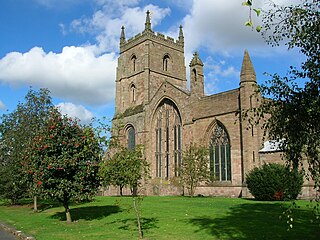
Leominster is a market town in Herefordshire, England; it is located at the confluence of the River Lugg and its tributary the River Kenwater. The town is 12 miles north of Hereford and 7 miles south of Ludlow in Shropshire. With a population of 11,700, Leominster is the largest of the five towns in the county; the others being Ross-on-Wye, Ledbury, Bromyard and Kington.
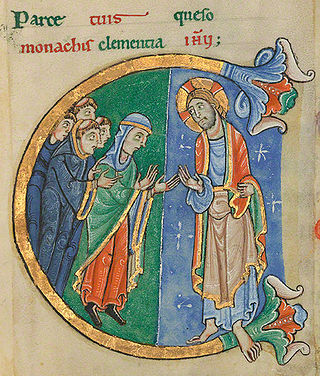
Christina of Markyate was born with the name Theodora in Huntingdon, England, about 1096–1098 and died about 1155. She was an anchoress, who came from a wealthy English family trying to accommodate with the Normans at that time. She later became the prioress of a community of nuns.

A double monastery is a monastery combining separate communities of monks and of nuns, joined in one institution to share one church and other facilities. The practice is believed to have started in the East at the dawn of monasticism. It is considered more common in the monasticism of Eastern Christianity, where it is traceable to the 4th century. In the West the establishment of double monasteries became popular after St. Columbanus and sprang up in Gaul and in Anglo-Saxon England. Double monasteries were forbidden by the Second Council of Nicaea in 787, though it took many years for the decree to be enforced. Double monasteries were revived again after the 12th century in a significantly different way when a number of religious houses were established on this pattern among Benedictines and possibly the Dominicans. The 14th-century Bridgittines were purposely founded using this form of community.

Edith of Wilton was an English saint, nun and member of the community at Wilton Abbey, and the daughter of Edgar, King of England and Saint Wulfthryth. Edith's parents might have been married and Edgar might have abducted Wulfthryth from Wilton Abbey, but when Edith was an infant, Wulfthryth returned with Edith and their marriage was dissolved. Edith and her mother remained at Wilton for the rest of their lives.
Sweyn Godwinson, also spelled Swein, was the eldest son of Earl Godwin of Wessex, and brother of Harold II of England.

The English Benedictine Congregation (EBC) is a congregation of autonomous abbatial and prioral monastic communities of Catholic Benedictine monks, nuns, and lay oblates. It is technically the oldest of the nineteen congregations affiliated to the Benedictine Confederation.

Godstow is a hamlet about 2.5 miles (4 km) northwest of the centre of Oxford. It lies on the banks of the River Thames between the villages of Wolvercote to the east and Wytham to the west. The ruins of Godstow Abbey, also known as Godstow Nunnery, are here. A bridge spans the Thames and the Trout Inn is at the foot of the bridge across the river from the abbey ruins. There is also a weir and Godstow lock.

Barking Abbey is a former royal monastery located in Barking, in the London Borough of Barking and Dagenham. It has been described as having been "one of the most important nunneries in the country".

Saint Mildrith, also Mildthryth, Mildryth and Mildred,, was a 7th- and 8th-century Anglo-Saxon abbess of the Abbey at Minster-in-Thanet, Kent. She was declared a saint after her death, and, in 1030, her remains were moved to Canterbury.
Wherwell Abbey was an abbey of Benedictine nuns in Wherwell, Hampshire, England.

The Priory Church is an Anglican parish church in Leominster, Herefordshire, England, dedicated to Saint Peter and Saint Paul. The building was constructed for a Benedictine Priory in about the 13th century, although there had been an Anglo-Saxon monastery in Leominster, possibly on the same site. In 1539 the east end of the church was destroyed along with most of the monastic buildings, but the main body of the church was preserved.
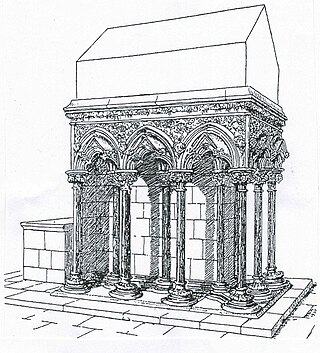
Ely Abbey was an Anglo-Saxon monastic establishment on the Isle of Ely first established in 673 by Æthelthryth the daughter of Anna, King of East Anglia. The first establishment was destroyed by the Danes in 870, but Edgar, King of England re-established the monastery in 970 as part of the English Benedictine Reform.
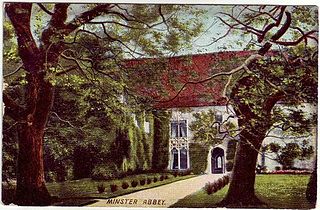
Minster Abbey is the name of two abbeys in Minster-in-Thanet, Kent, England. The first was a 7th-century foundation which lasted until the Dissolution of the Monasteries. Beside its ruins is St Mildred's Priory, a Benedictine community of women founded in 1937.
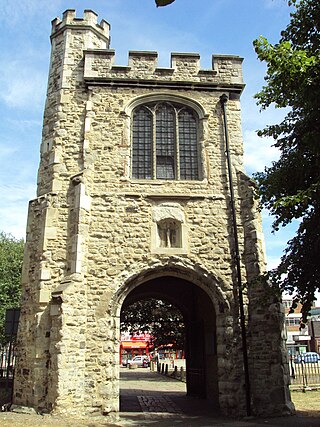
Hildelith of Barking, also known as Hildilid or Hildelitha, was an 8th-century Christian saint, from Anglo-Saxon England but was of foreign origin.
Wulfthryth, also known as Wilfrida, was the second known consort of Edgar, King of England, in the early 960s. Historians disagree whether she was his wife or mistress. In 964, Edgar married Ælfthryth, and then or earlier Wulfthryth returned to Wilton Abbey, where she had been educated. She was accompanied by her daughter Edith, who was widely revered in the eleventh century as a saint. Wulfthryth remained there for the rest of her life as abbess and died on 21 September in an unknown year, around 1000. She was regarded as a saint at Wilton, but her cult did not spread more widely.
Wulfhilda, also known as Wulfhild and Wulfreda among several other names, was an Anglo-Saxon abbess who is venerated as a saint in the Catholic Church.

Hatfield and Newhampton is a civil parish in the county of Herefordshire, England, and is 11 miles (18 km) north from the city and county town of Hereford. The closest large town is Leominster 4 miles (6 km) to the west. The parish includes the small village of Hatfield, the former extra-parochial liberty of New Hampton, the site of former abbey lands of Fencote, the preserved Fencote railway station, and the Grade II* listed 11th-century Church of St Leonard.
Matilda de Bailleul aka Maud was a Flemish abbess of the English Wherwell Abbey. She arrived in 1173 and transformed the abbey that had few nuns following damage done by William of Ypres years before. She annotated and then gifted an illuminated psalter to her successors which is known as the Saint Bertin psalter.















